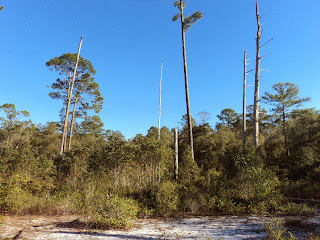Trail: Oak Woods Loop
Hike Location: Little Ocmulgee State Park
Geographic Location: north side of McRae , GA (32.09427, -82.89582)
Length: 1.9 miles
Difficulty: 2/10 (Easy)
Difficulty: 2/10 (Easy)
Dates Hiked: February 2008, December 2013
Overview: An easy hike exploring the coastal sand hills and surrounding habitats.
Park Information: http://www.littleocmulgeelodge.com/
Directions to the trailhead: Between Macon and Savannah , take I-16 to US 319 (exit 51). Exit and go south on US 319. Take US 319 28 miles to the park entrance on the right. Enter the park and pay the nominal entrance fee at the fee station. Where the lodge road exits right, continue straight, heading for the Visitor Center Visitor Center
The hike: Located in the coastal plain some 70 miles southeast of Macon , Little Ocmulgee State Park represents one of south Georgia’s brightest recreation gems. The centerpieces of the park are the 265 acre lake, which offers a swimming beach as well as boating and fishing opportunities, and the 60 room lodge and conference center capable of hosting a wide variety of events. Other lodging opportunities include a 55 site campground and 10 cottages available for rent.
In terms of recreation, while the lake takes center stage, an 18 hole championship golf course, 9 picnic shelters, 2 tennis courts, and a miniature golf course combine to make this a recreation paradise. Even better, the park’s southern location allows these outdoor recreation options to be used comfortably for most of the year.
For hikers, the park offers a pair of concentric loop trails that rank among the finest in the region. The 1.9 mile Oak Ridge Loop and the inner 1.5 mile Magnolia Loop provide very pleasant hikes on wide well-maintained trails. Combining these trails with the trails at Ocmulgee National Monument Macon would make a nice full day of hiking through a wide variety of natural habitat and human history.
 |
| Trailhead |
Just after crossing the stream, 0.2 miles into the hike, the trail forks to form the loop. To travel the same direction as the numbers for the brochures, you will need to turn right here and use the left trail as the return route. Angling right, the trail climbs gradually through scrubby forest featuring a dense understory of deerberry and sand hickory, among others. The soft sand underfoot gives this hike very much a coastal feel even though the ocean is over 100 miles away.
 |
| Hiking through "coastal" forest |
 |
| Sandy trail in sand hills |
At the midpoint of the hike, the trail curves left and begins heading gradually downhill back toward the lake. As you descend, notice a series of five tall dead pine trees on the left. Vultures and hawks love the sand hills as the heat from the sand helps support them in glide, and on my visit I saw no less than 22 vultures perched on these five trees. Keep your eyes open and find out how many you see.
 |
| Dead pines |
 |
| Swamp boardwalk |

No comments:
Post a Comment